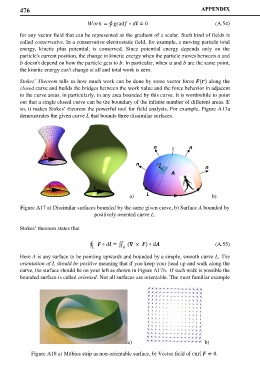Page 496 - Maxwell House
P. 496
476 APPENDIX
= ∮ grad ∘ ≡ 0 (A.54)
for any vector field that can be represented as the gradient of a scalar. Such kind of fields is
called conservative. In a conservative electrostatic field, for example, a moving particle total
energy, kinetic plus potential, is conserved. Since potential energy depends only on the
particle's current position, the change in kinetic energy when the particle moves between and
doesn't depend on how the particle gets to . In particular, when and are the same point,
the kinetic energy can't change at all and total work is zero.
Stokes’ Theorem tells us how much work can be done by some vector force () along the
closed curve and builds the bridges between the work value and the force behavior in adjacent
to the curve areas, in particularly, in any area bounded by this curve. It is worthwhile to point
out that a single closed curve can be the boundary of the infinite number of different areas. If
so, it makes Stokes’ theorem the powerful tool for field analysis. For example, Figure A17a
demonstrates the given curve L that bounds three dissimilar surfaces.
a) b)
Figure A17 a) Dissimilar surfaces bounded by the same given curve, b) Surface A bounded by
positively oriented curve L.
Stokes’ theorem states that
∮ ∘ = ∬ ( × ) ∘ (A.55)
Here A is any surface to be pointing upwards and bounded by a simple, smooth curve L. The
orientation of L should be positive meaning that if you keep your head up and walk along the
curve, the surface should be on your left as shown in Figure A17b. If such walk is possible the
bounded surface is called oriented. Not all surfaces are orientable. The most familiar example
a) b)
Figure A18 a) Möbius strip as non-orientable surface, b) Vector field of curl ≠ 0.

